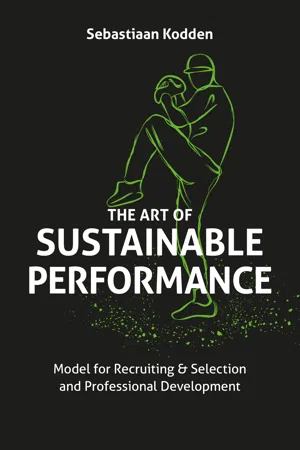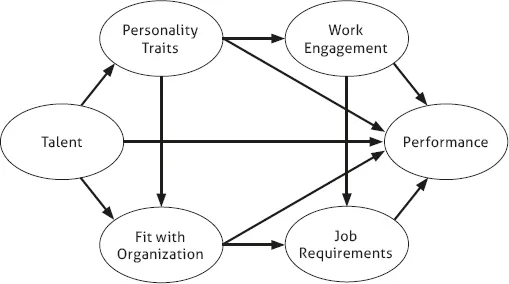
eBook - ePub
The Art of Sustainable Performance
Model for Recruiting & Selection and Professional Development
- 208 pages
- English
- ePUB (mobile friendly)
- Available on iOS & Android
eBook - ePub
The Art of Sustainable Performance
Model for Recruiting & Selection and Professional Development
About this book
Sebastiaan Kodden studied performance indicators among executives and senior staff of over 1, 100 professionals and 50 CEOs of the best-known Dutch companies.
His surprising findings put the present recruitment and selection procedures of many Dutch companies in a new perspective. The book is not only about the theory: it also offers a useful model for recruitment, selection and professional development. Including various questionnaires and checklists for HR-professionals and executives who want to build sustainable winning teams and organizations.
Frequently asked questions
Yes, you can cancel anytime from the Subscription tab in your account settings on the Perlego website. Your subscription will stay active until the end of your current billing period. Learn how to cancel your subscription.
At the moment all of our mobile-responsive ePub books are available to download via the app. Most of our PDFs are also available to download and we're working on making the final remaining ones downloadable now. Learn more here.
Perlego offers two plans: Essential and Complete
- Essential is ideal for learners and professionals who enjoy exploring a wide range of subjects. Access the Essential Library with 800,000+ trusted titles and best-sellers across business, personal growth, and the humanities. Includes unlimited reading time and Standard Read Aloud voice.
- Complete: Perfect for advanced learners and researchers needing full, unrestricted access. Unlock 1.4M+ books across hundreds of subjects, including academic and specialized titles. The Complete Plan also includes advanced features like Premium Read Aloud and Research Assistant.
We are an online textbook subscription service, where you can get access to an entire online library for less than the price of a single book per month. With over 1 million books across 1000+ topics, we’ve got you covered! Learn more here.
Look out for the read-aloud symbol on your next book to see if you can listen to it. The read-aloud tool reads text aloud for you, highlighting the text as it is being read. You can pause it, speed it up and slow it down. Learn more here.
Yes! You can use the Perlego app on both iOS or Android devices to read anytime, anywhere — even offline. Perfect for commutes or when you’re on the go.
Please note we cannot support devices running on iOS 13 and Android 7 or earlier. Learn more about using the app.
Please note we cannot support devices running on iOS 13 and Android 7 or earlier. Learn more about using the app.
Yes, you can access The Art of Sustainable Performance by Sebastiaan Kodden in PDF and/or ePUB format, as well as other popular books in Business & Human Resource Management. We have over one million books available in our catalogue for you to explore.
Information
1 The Importance of Sustainable Development
The same thing that happened with Billy Beane’s scouts, seems to be happening in our world. Research shows that candidates are selected mostly based on the estimated talent, past achievements and characteristics that their (new) employers – often subconsciously – see in themselves.8 The results are alarming. Even today, it turns out that 88% of Dutch professionals are not fully engaged when it comes to their jobs. What makes it even worse is that levels of engagement appear to be declining. Less than 77% of all Dutch employees indicate that they are happy in their jobs, 5% of the Dutch workforce are currently suffering a burn-out and another 13% are close to it. Today, more people are not working because of mental health issues than physical illnesses.
A hundred years after Frederick Taylor, we are still dulling each other’s intrinsic motivation. A few years ago, a large poll carried out by Gallup among 230,000 employees from 142 countries showed that only 13% felt engaged at work. The Netherlands scored even worse than average: only 9% were genuinely enthusiastic about their jobs.9 According to psychologist Barry Schwartz, 90% of adults spend half their waking lives on things they would rather not be doing and in places where they would rather not be.10
According to the Chartered Institute of Personnel and Development (CIPO), the costs of a mismatch between vacancy and candidate are equal to two-and-a-half annual salaries of that person. In one of its studies, Harvard Business School even calculated an amount three to five times the annual salary. Even ten times in the case of highly specialized positions or generalist top-level positions in an organization. This shows that, just as a cost consideration, it is important to overlook as little as possible when it comes to recruitment and selection of new talent. And that does not even include all the potential social and personal consequences. Another issue is the number of candidates that miss out on suitable jobs and great opportunities, simply because the wrong candidate was hired.
“Keep your eyes on the stars and your feet on the ground.”
Theodore Roosevelt, US president (1858-1919)
Intrinsic Motivation
“When you let those numbers sink in, you realize how much ambition and energy currently are shelved,” writes Rutger Bregman in De Correspondent. Imagine when we all were committed to each other’s intrinsic motivation. That would mean a major revolution. CEOs would do their jobs because they believed in their companies, scientists would put in long hours simply out of curiosity and teachers would teach because they’d feel a responsibility towards their students. Psychologists would keep treating their patients as long as it takes and bankers would get their satisfaction from their role as service providers. Professionalism and competence would be paramount, not efficiency and productivity. However, this requires a completely different approach to talent and performance management.11 One that supposes: “Talent is good, but character is better.”
As was previously concluded by researchers from the University of Amsterdam in a large-scale study in cooperation with Randstad, Dutch CEOs and recruiters mainly look for talent, experience and specific knowledge and skills.12 Although this approach seems useful for clearly defined jobs, we should be aware that jobs and job requirements change over time.
Knowledge expires quickly – and is even expiring more quickly all the time – yet new knowledge and skills seem crucial in today’s rapidly changing market. Supervisors and HR specialists should therefore pay more attention to their candidates’ personalities, i.e. their mental capabilities, specific personality traits and sustainable employability.13
Successful Selection
On the basis of extensive research carried out by Schmidt and Hunter14 and others, we can conclude that certain selection methods will yield more information about candidates than others. Because the results of Schmidt and Hunter are based on large, international and random testing, their article is still the basis for many studies on recruitment and selection methods today. Researchers from the University of Amsterdam reached similar conclusions in 2008. The methods that provide the best insight into an applicant’s capabilities are the verifiable task achievements of the candidate (which requires the employee to have been working and performing within the organization for some time), an aptitude test that tests mental abilities and a structured selection interview. An individual’s references are poor indicators of his future performance.15
“Get the right people on the bus.”
Jim Collins (1958)
“Get the right people on the bus,” was the most important advice of management expert Jim Collins in his book Good to Great. One of the participants in the Sports Leadership Program where I teach, Max Caldas, coach of the Dutch men’s field hockey team, expressed it as follows: “You are the average of the people around you.” But then what traits are the decisive factors for professionals who manage to keep performing, and how do you select them?
Performance Indicators and Selection Criteria
My very own Moneyball was born. I began a study on performance indicators and personality traits among over 1,100 professionals, three times the required sample size.16 I included over twenty performance indicators in a research model based on five general concepts that I had mapped out after consulting with scientific and professional sports experts, studying scientific articles and reading many different management books. These five general concepts related to the importance of:
1.the degree of talent present;
2.the degree of presence of certain personality traits;
3.the degree of fit with the organization;
4.the degree of enthusiasm;
5.the degree of fit with the (physical and mental) requirements.
These concepts and their individual elements were linked to the ability of professionals to deliver sustainable performance, both in a team and on an individual level. Delivering sustainable performance is defined in this study as being able to repeatedly achieve personal and team goals.
The afore-mentioned concepts are visualized in the research model below:

FIGURE 1.THE RESEARCH MODEL
I decided to use this research model to ask supervisors and senior employees how they would rate random employees or co-workers (with answers such as: totally agree, agree, neither agree nor disagree, disagree and totally disagree) using questions such as:
•Compared to his or her co-workers, this employee has on average much less / less / neither less nor more / more / much more natural talent and innate predisposition to excel at his or her job.
•Compared to his or her co-workers this employee has on average much less / less / neither less nor more / more / much more willpower to excel.
•This employee has above-average intrinsic motivation to excel.
•This employee has above-average confidence in difficult situations.
Research Model and Questions
The model resulted in the following six research questions:
1.To what degree is talent important for sustainable performance by professionals?
2.To what degree are certain personality traits important for sustainable performance by professionals?
3.To what degree is enthusiasm important for sustainable performance by professionals?
4.To what degree do physical and mental job requirements influence sustainable performance by professionals?
5.To what degree is a good fit with the organization important for sustainable performance by professionals? And finally:
6.To what degree does the applied research model have a good statistical fit, and can it be used as a framework for talent development, and recruitment and selection services?
Following this methodology, a total of over 1,100 profession...
Table of contents
- Cover Page
- Dedication
- Title Page
- Copyright
- Table of Contents
- Foreword Henk Ouwens
- Prologue: Billy Beane
- Introduction
- 1 The Importance of Sustainable Development
- 2 Talent
- 3 Intelligence, Willpower and Intrinsic Motivation
- 4 Adaptability
- 5 Self-efficacy
- 6 Work Engagement
- 7 Vigor
- 8 Organizational Fit
- 9 Performance Culture – All Blacks
- 10 The Art of Sustainable Performance: The Zeigarnik Effect
- Conclusion and Summary
- Tools
- Appendices
- Notes
- Sources of Inspiration
- Acknowledgements
- About the Author
- Back Cover